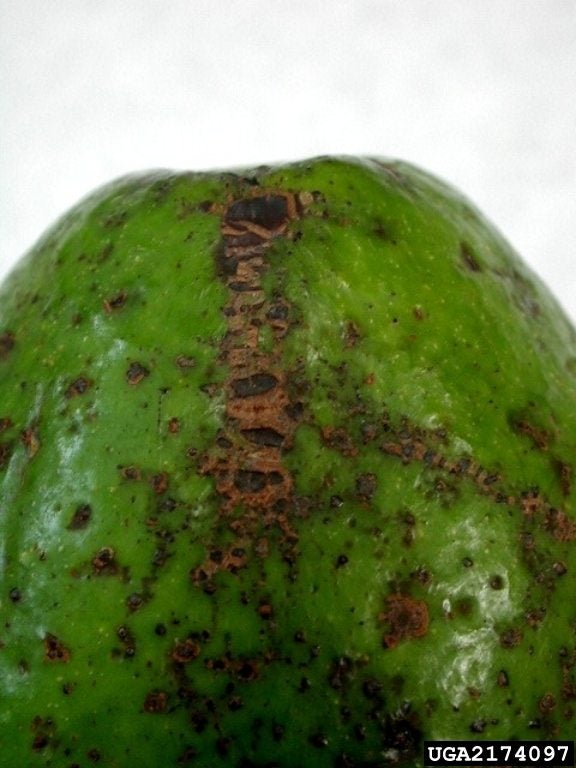Avocado Scab Control: Tips On Treating Scab On Avocado Fruit

Avocados are a delicious, healthful fruit that, like all crops, may become afflicted with a disease. Avocado scab disease is one such problem. While initially scab on avocado fruit is a cosmetic issue, it may become a gateway for the entry of fruit rotting organisms such as anthracnose. Because of this, treating avocado scab is an important step to preserving the crop. Identifying scab symptoms in avocado will better enable the grower to apply avocado scab control.
What is Scab on Avocado Fruit?
Avocado scab disease is caused by the fungus Sphaceloma perseae. Scab symptoms on avocadoes present as oval to round, raised areas of corky scab. The first lesions that appear are generally black/brown and scattered across the fruit’s skin. The lesions begin to coalesce and merge, potentially affecting almost the entirety of the fruit. Symptoms of scab on the leaves are more difficult to ascertain, as the most visible signs are in the uppermost portions of the tree’s canopy. Young leaves may become distorted and stunted with reddish spots on both the upper and lower sides of the foliage. Scab symptoms on avocado may be confused with physical damage. Fruit is most susceptible right after fruit set and during the early stages of development. When the fruit is at about half its mature size, it becomes resistant to the infection, as do leaves once they are about a month old. The disease is most prevalent after long periods of rain, especially when the tree is in its initial stages of fruit set.
Avocado Scab Control
Although the disease is primarily cosmetic, affecting the exterior of the fruit but not the interior, it is a portal for other diseases, so treating avocado scab before any sign of infection is necessary to the health of the tree and resulting fruit. Also, since scab is spread by the dispersal of spores produced at the early stages of infection and then spread through the movement of wind, rain, and tools or equipment, the pathogen can travel over long distances. Fungicides should be used to mitigate the spread of the fungus. Treatment involves the application of copper fungicide when flower buds appear, near the end of bloom time and again 3-4 weeks after.
Gardening tips, videos, info and more delivered right to your inbox!
Sign up for the Gardening Know How newsletter today and receive a free copy of our e-book "How to Grow Delicious Tomatoes".

Amy Grant has been gardening for 30 years and writing for 15. A professional chef and caterer, Amy's area of expertise is culinary gardening.
-
 Grow ‘Karl Rosenfield’ Peony Plants For The Ultimate Frilly Border Beauties And Cut Flowers
Grow ‘Karl Rosenfield’ Peony Plants For The Ultimate Frilly Border Beauties And Cut FlowersFor frilly double magenta peony petals infused with a heady fragrance, grow ‘Karl Rosenfield’ peony plants. Here’s how to cultivate the ultimate plushy blooms
By Tonya Barnett
-
 10 Common Composting Problems That Can Spoil Your Garden Gold – Plus Easy Fixes
10 Common Composting Problems That Can Spoil Your Garden Gold – Plus Easy FixesLearn how to troubleshoot common composting issues before they ruin your stash – from bad smells and bugs to materials not breaking down as they should.
By Susan Albert